“Kettle on? Ere boy, now this’ll interest you. Got it at a Charity Shop. There’s a bit in it about a Liberator that was repaired using a telegraph pole!” He has a knack does Trevor for finding the unlikely in the unknown and this was a classic example, a little book all about RAF Watton and its USAAF connections. What was so special about the place was that it was home to 3rd Strategic Air Depot (SAD), a heavy maintenance depot for the USAAF Liberators. At any one time there were around 4500 personnel on the repair and maintenance side alone making this one of the biggest USAAF stations operating in the European Theatre yet for reasons various, not least the clandestine nature of the operations carried out by 652nd, 653rd and 654th Bombardment Squadrons that also lived there, little is ever mentioned of it. Trevor of course has been there as it was home to USAAF Mosquitos. Now there’s a thing!
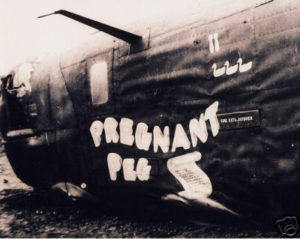 Apart from rebuilding and repairing bombers that were beyond the scope of the line mechanics and engineers at the bases they also salvaged the crashed and damaged Liberators that had only just made it back to the green fields of England and on occasions rebuilt forced landed aircraft in the field they had arrived in and flew them back to Watton. To support all this activity there was a fleet of trucks that would rival UPS and acres of reclaimed spares and, naturally, scrap! For many Liberators in trouble Watton airfield was where they tried to make for, putting down the damaged aircraft as best they could on the grass. Needless to say they had a very large comprehensive hospital there. This little book Trevor had found was full of personal photographs taken by the US airmen based there and covered everything from the accommodation to the acres of salvaged aircraft parts and maintenance depot along with the Mosquitos used for the meteorological flights, night aerial photography using flashbombs and the visitors to the base including Marlene Dietrich!
Apart from rebuilding and repairing bombers that were beyond the scope of the line mechanics and engineers at the bases they also salvaged the crashed and damaged Liberators that had only just made it back to the green fields of England and on occasions rebuilt forced landed aircraft in the field they had arrived in and flew them back to Watton. To support all this activity there was a fleet of trucks that would rival UPS and acres of reclaimed spares and, naturally, scrap! For many Liberators in trouble Watton airfield was where they tried to make for, putting down the damaged aircraft as best they could on the grass. Needless to say they had a very large comprehensive hospital there. This little book Trevor had found was full of personal photographs taken by the US airmen based there and covered everything from the accommodation to the acres of salvaged aircraft parts and maintenance depot along with the Mosquitos used for the meteorological flights, night aerial photography using flashbombs and the visitors to the base including Marlene Dietrich!
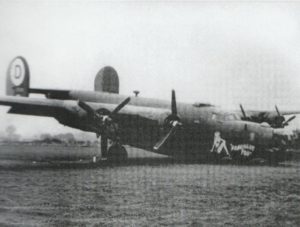 Now the last time we did something on an American aircraft was the ‘In search of Snafu and the nose art of the Flying Fortress’ after our man found a picture of a B17. This time the hook turned out equally interesting and ultimately tragic. There was indeed a picture of a B24H Liberator, 42-7491 ‘Pregnant Peg’, that had put down in a field and was subsequently flown to Watton with an electricity pole holding it all together. Now it didn’t seem likely that there would be much about this as the aircraft wasn’t reported missing but it turned out that a few months after the incident it was in the local paper. War time reporting and all that meant news was never instant and seldom that factual! These days things are a little different and the service records of both airmen and the aircraft, never mind the squadrons, is all out there. It takes a bit of searching out and at times can be quite confusing as reported stories often tend to be at variance with the facts and the urban myth has fuddled things but you can get pretty close so it was that with some footy match or other on the telly and it being a no beer Tuesday the evening was given over to a bit of research.
Now the last time we did something on an American aircraft was the ‘In search of Snafu and the nose art of the Flying Fortress’ after our man found a picture of a B17. This time the hook turned out equally interesting and ultimately tragic. There was indeed a picture of a B24H Liberator, 42-7491 ‘Pregnant Peg’, that had put down in a field and was subsequently flown to Watton with an electricity pole holding it all together. Now it didn’t seem likely that there would be much about this as the aircraft wasn’t reported missing but it turned out that a few months after the incident it was in the local paper. War time reporting and all that meant news was never instant and seldom that factual! These days things are a little different and the service records of both airmen and the aircraft, never mind the squadrons, is all out there. It takes a bit of searching out and at times can be quite confusing as reported stories often tend to be at variance with the facts and the urban myth has fuddled things but you can get pretty close so it was that with some footy match or other on the telly and it being a no beer Tuesday the evening was given over to a bit of research.
 The first account of the Pregnant Peg we turned up was in the June 2008 392nd Bomb Group Memorial Association’s Newsletter’s ‘Questions and Answers’ section where the question was ‘How long a runway does a B-24 need to take-off?’ They’d found an article in the Stars & Stripes newspaper for 21 December 1943 entitled “How Pregnant Peg was Delivered of a New Life.” It recounted the story of how, with a tired crew, low on fuel, in bad weather and unable to locate the airfield pilot Lt Robert Copp brought her into a belly landing in a ploughed field. Following makeshift repairs in the field, serious lightening of the aircraft and the building of a temporary runway about 1500 feet long, which immediately turned to mud a certain Major Allen eventually managed to fly her out. The account in Stars and Stripes reads, “Maj Allen G. Russell, chief of operations for 8th Air Force Service Command’s Ferry and Transport Service, was asked to fly Pregnant Peg out. To lighten the a/c, he took out all the guns and the nose turret. The next job was to move the mired ship to level ground next to the runway. To lessen the weight on the half-buried nose wheel, Russell placed ten men in the tail and gunned his engines hard. That, plus helpful tugs from a tractor, snaked the big bomber out of the mud and she lurched forward to the desired location.”Stars & Stripes continued, “To get the traction required for acceleration and take-off, he placed the ship at right angles to the runway, applied the brakes, and revved up the engines. The big moment had arrived. Russell released the brakes and swerved the ship into the makeshift runway with a thundering roar. The wheels skidded round the turn in eight inches of mud. There was a breathless moment as the Lib rolled forward faster and faster and then its silhouette rose against the twilight sky. Pregnant Peg was airborne again.” The take-off run had been an amazing 841 feet, somewhat shorter than the recommended 4000 foot normally required!” Following on, they had turned up a bit more information on the incident. “Long-time Beeston resident Ernie Parke met Robert Copp in the late 1970s. In a letter in the Spring 2008 issue of the Second Air Division Journal, he wrote that Copp told him they had to abort the mission because of dense fog. They couldn’t see the base, fuel was running low, and they were too close to the ground to bail out. In fact, when there was a break in the fog they saw a church and they were below the steeple! Then, Copp found an empty field near the village of Ashill and set Pregnant Peg down.
The first account of the Pregnant Peg we turned up was in the June 2008 392nd Bomb Group Memorial Association’s Newsletter’s ‘Questions and Answers’ section where the question was ‘How long a runway does a B-24 need to take-off?’ They’d found an article in the Stars & Stripes newspaper for 21 December 1943 entitled “How Pregnant Peg was Delivered of a New Life.” It recounted the story of how, with a tired crew, low on fuel, in bad weather and unable to locate the airfield pilot Lt Robert Copp brought her into a belly landing in a ploughed field. Following makeshift repairs in the field, serious lightening of the aircraft and the building of a temporary runway about 1500 feet long, which immediately turned to mud a certain Major Allen eventually managed to fly her out. The account in Stars and Stripes reads, “Maj Allen G. Russell, chief of operations for 8th Air Force Service Command’s Ferry and Transport Service, was asked to fly Pregnant Peg out. To lighten the a/c, he took out all the guns and the nose turret. The next job was to move the mired ship to level ground next to the runway. To lessen the weight on the half-buried nose wheel, Russell placed ten men in the tail and gunned his engines hard. That, plus helpful tugs from a tractor, snaked the big bomber out of the mud and she lurched forward to the desired location.”Stars & Stripes continued, “To get the traction required for acceleration and take-off, he placed the ship at right angles to the runway, applied the brakes, and revved up the engines. The big moment had arrived. Russell released the brakes and swerved the ship into the makeshift runway with a thundering roar. The wheels skidded round the turn in eight inches of mud. There was a breathless moment as the Lib rolled forward faster and faster and then its silhouette rose against the twilight sky. Pregnant Peg was airborne again.” The take-off run had been an amazing 841 feet, somewhat shorter than the recommended 4000 foot normally required!” Following on, they had turned up a bit more information on the incident. “Long-time Beeston resident Ernie Parke met Robert Copp in the late 1970s. In a letter in the Spring 2008 issue of the Second Air Division Journal, he wrote that Copp told him they had to abort the mission because of dense fog. They couldn’t see the base, fuel was running low, and they were too close to the ground to bail out. In fact, when there was a break in the fog they saw a church and they were below the steeple! Then, Copp found an empty field near the village of Ashill and set Pregnant Peg down. 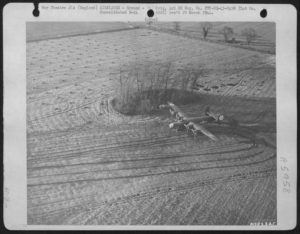 The nose wheel broke when it hit the bank at the side of the road. Electric poles were strapped in to strengthen the fuselage. Copp went out twice to fly Peg off but the wind wasn’t right. Eventually, the a/c was flown away by Major Russell.” Under the picture in the booklet Trevor had found it simply said that “Pregnant Peg was flown over from nearby Shipdham with a telegraph pole strapped inside her keeping it all together. The pilot declared that he never went over 200 feet the whole way. Eye witnesses claimed he never even got to 200 feet!” Major Russell wasn’t alone though as he took his crew chief, T/Sgt Cecil F. Grove, along for the ride!
The nose wheel broke when it hit the bank at the side of the road. Electric poles were strapped in to strengthen the fuselage. Copp went out twice to fly Peg off but the wind wasn’t right. Eventually, the a/c was flown away by Major Russell.” Under the picture in the booklet Trevor had found it simply said that “Pregnant Peg was flown over from nearby Shipdham with a telegraph pole strapped inside her keeping it all together. The pilot declared that he never went over 200 feet the whole way. Eye witnesses claimed he never even got to 200 feet!” Major Russell wasn’t alone though as he took his crew chief, T/Sgt Cecil F. Grove, along for the ride!
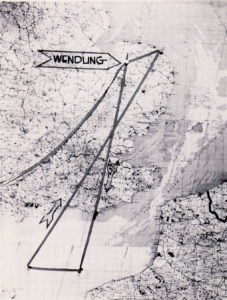 Now we had a bit more information it now seemed that the story could be pieced together slightly more accurately. Although the date of the accident is not known for sure the records show that 1st Lt Robert D Copp of 577th Squadron flew a Diversion Mission on 18th October and, after delving deeper into the missions list, on the 20th October Lt Copp is listed as flying 491 on another Diversion Mission from Wendling to cover a B-17 raid on Duran. After the 20th October 491 isn’t shown as flying again until February 1944 and Copp’s next mission on 5th November to Munster is in 496 ‘The Jinx’. Another clue are the ducks painted under the cockpit in place of bombs to signify a Diversion or Decoy mission thus the picture of the nose down Pregnant Peg denotes that at least two bombing raids and three decoy missions had already been completed. Considering 391 had come to the Squadron on 10th August 1943 this fits the time line and although we reckon he has a duck missing as it was only two days before and the weather was bad there probably hadn’t been an opportunity to paint it on! It also just so happens there is a route map for the mission on the 20th which shows the route took them south into the Channel where they turned back flying up to the north Norfolk coast and then turning again to head back to Wendling. Checking their probable track against the one they should have taken on the jolly OS map it seems that as a result of the poor weather they came slightly south of Wendling thus missing it before putting down at Ashill only six miles to the southwest with Watton only three miles to the south east. Now there aren’t that many churches with spires in this part of Norfolk and looking at their most likely track the only one they would
Now we had a bit more information it now seemed that the story could be pieced together slightly more accurately. Although the date of the accident is not known for sure the records show that 1st Lt Robert D Copp of 577th Squadron flew a Diversion Mission on 18th October and, after delving deeper into the missions list, on the 20th October Lt Copp is listed as flying 491 on another Diversion Mission from Wendling to cover a B-17 raid on Duran. After the 20th October 491 isn’t shown as flying again until February 1944 and Copp’s next mission on 5th November to Munster is in 496 ‘The Jinx’. Another clue are the ducks painted under the cockpit in place of bombs to signify a Diversion or Decoy mission thus the picture of the nose down Pregnant Peg denotes that at least two bombing raids and three decoy missions had already been completed. Considering 391 had come to the Squadron on 10th August 1943 this fits the time line and although we reckon he has a duck missing as it was only two days before and the weather was bad there probably hadn’t been an opportunity to paint it on! It also just so happens there is a route map for the mission on the 20th which shows the route took them south into the Channel where they turned back flying up to the north Norfolk coast and then turning again to head back to Wendling. Checking their probable track against the one they should have taken on the jolly OS map it seems that as a result of the poor weather they came slightly south of Wendling thus missing it before putting down at Ashill only six miles to the southwest with Watton only three miles to the south east. Now there aren’t that many churches with spires in this part of Norfolk and looking at their most likely track the only one they would 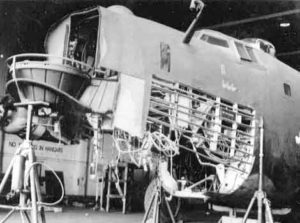 have passed would have been at Bawdeswell, which fits well with Copp’s description of the event and meaning that they would have gone almost directly overhead RAF Swanton Morley a couple of minutes later. Taking all that into account we therefore think its a safe bet that it was the 20th October that Pregnant Peg ended up in a field in Ashill. When it was flown out is a different matter but it was soon at Watton, put in the hangar and the nose rebuilt as the photo shows. Whether it got its missing ducks we’ll never know.
have passed would have been at Bawdeswell, which fits well with Copp’s description of the event and meaning that they would have gone almost directly overhead RAF Swanton Morley a couple of minutes later. Taking all that into account we therefore think its a safe bet that it was the 20th October that Pregnant Peg ended up in a field in Ashill. When it was flown out is a different matter but it was soon at Watton, put in the hangar and the nose rebuilt as the photo shows. Whether it got its missing ducks we’ll never know.
 What is always foremost on your mind when checking these stories is the fate of the crew. Fortunately 1st Lt Copp (left) and his crew survived the war and in a piece he wrote for b24.net it is likely that they are one of the very few crews in the 577th that completed their 28 missions. He arrived at Wendling and joining the Squadron in August 1943 and his first mission was to Abbeyville in France on September 9th 1943. He did describe that the turnover of crews “was so great that it was not uncommon to be among strangers, even in your own squadron”. He does make mention of a crash landing and one of a fire onboard over England when six of his crew baled out without injury. Pregnant Peg was his original aircraft but, as was the case, he flew others. He flew the lead aircraft 42-52642 in the fateful Berlin Raid of April 29th 1944 when eight of the eighteen aircraft were lost. He finished his tour as a Captain in May 1944 and returned to the States to become a Training Captain. He wrote “I was never one to keep diaries, records, or take pictures during the war years. Recollections of events and people are difficult to conjure up after so many decades have passed; but it’s evident that many of us traveled the same route in training from Davis Mountain to Topeka to Wendling. It is unbelievable to me that my crew went through this ordeal without as much as a scratch”. Check out the link for his story.
What is always foremost on your mind when checking these stories is the fate of the crew. Fortunately 1st Lt Copp (left) and his crew survived the war and in a piece he wrote for b24.net it is likely that they are one of the very few crews in the 577th that completed their 28 missions. He arrived at Wendling and joining the Squadron in August 1943 and his first mission was to Abbeyville in France on September 9th 1943. He did describe that the turnover of crews “was so great that it was not uncommon to be among strangers, even in your own squadron”. He does make mention of a crash landing and one of a fire onboard over England when six of his crew baled out without injury. Pregnant Peg was his original aircraft but, as was the case, he flew others. He flew the lead aircraft 42-52642 in the fateful Berlin Raid of April 29th 1944 when eight of the eighteen aircraft were lost. He finished his tour as a Captain in May 1944 and returned to the States to become a Training Captain. He wrote “I was never one to keep diaries, records, or take pictures during the war years. Recollections of events and people are difficult to conjure up after so many decades have passed; but it’s evident that many of us traveled the same route in training from Davis Mountain to Topeka to Wendling. It is unbelievable to me that my crew went through this ordeal without as much as a scratch”. Check out the link for his story.
Amongst other notable aviation jobs before the war, Major Russell from North Hollywood  California, the pilot that flew Pregnant Peg out, was the pilot for the noted newspaper publisher William Randolf Hearst. In June 1943 he was presented with the Distinguished Flying Cross for flying three crash-landed bombers out of a thickly wooded field making him one of the first members of the 8th Air Force Service Command in the European Theatre to receive an award and subsequently to get the job of saving Pregnant Peg!
California, the pilot that flew Pregnant Peg out, was the pilot for the noted newspaper publisher William Randolf Hearst. In June 1943 he was presented with the Distinguished Flying Cross for flying three crash-landed bombers out of a thickly wooded field making him one of the first members of the 8th Air Force Service Command in the European Theatre to receive an award and subsequently to get the job of saving Pregnant Peg!
 Sadly the story of Pregnant Peg has a far from happy ending. It was rebuilt at Watton and was transferred to the 578th Sqdn. She first flew in action again on 29 Feb 1944 piloted by W C Raschke on a Noball mission against V-weapon targets near Lottingham. The target was hastily requested after the Group had been briefed and finally scrubbed for a mission to Stuttgart. Target weather was poor and light snow was also falling at Wendling. There were no fighters encountered and very little flak resulting in the Group suffering no losses, damage or casualties. Three days later on the 3rd March 1944 she was off again with Lt Richard E Smith’s crew (left in the photograph) aboard on a mission to Oranienburg on the outskirts of Berlin to bomb the Heinkel Aircraft Factory. The report makes harrowing reading. The PFF (pathfinding) equipment in the lead ship was operating very poorly during assembly and eventually ceased to operate altogether. As a result, the lead ship aborted turning the job over to the deputy PFF ship about 65 miles off the English Coast at 18,500 ft. The actual assembly and formation was complicated by heavily layered clouds and extreme cold (some crews reported temperatures as low as -55° C) causing windows to frost over. Many guns and turrets froze and failed to operate and, in general, it was difficult to maintain formation integrity. Aircraft were constantly aborting across the North Sea and after crossing the enemy coast. At 1110, the 392nd sighted Helgoland (heavy ack-ack batteries) to the right and a turn at 1114 took the Group into a cloud bank. Despite climbing from 22,500 feet to 24,000 feet, the dense clouds persisted and the formation finally broke up. The decision to abandon operations was made at 1131. Most bombs were jettisoned in the North Sea or the Wash. No enemy aircraft were seen but moderate flak was met over Helgoland. Somewhere in the middle of all this, probably during form up, Pregnant Peg is presumed to have gone down or ditched in the North Sea with no survivors. 1st Lt Smith’s crew comprised, CoPilot – John E. Schilling, Navigator – Louis Metz, Bombarbier – Harry G Hopple, Radio Operator – Frank C. Clark, Engineer – Warren J. Wooton, Ball Gunner – William B. Sheppard, Waist Gunners – Walter J. Norton Jr, and Worth W. Heaslet and Tail Gunner – S/S Paul J. Bertsch.
Sadly the story of Pregnant Peg has a far from happy ending. It was rebuilt at Watton and was transferred to the 578th Sqdn. She first flew in action again on 29 Feb 1944 piloted by W C Raschke on a Noball mission against V-weapon targets near Lottingham. The target was hastily requested after the Group had been briefed and finally scrubbed for a mission to Stuttgart. Target weather was poor and light snow was also falling at Wendling. There were no fighters encountered and very little flak resulting in the Group suffering no losses, damage or casualties. Three days later on the 3rd March 1944 she was off again with Lt Richard E Smith’s crew (left in the photograph) aboard on a mission to Oranienburg on the outskirts of Berlin to bomb the Heinkel Aircraft Factory. The report makes harrowing reading. The PFF (pathfinding) equipment in the lead ship was operating very poorly during assembly and eventually ceased to operate altogether. As a result, the lead ship aborted turning the job over to the deputy PFF ship about 65 miles off the English Coast at 18,500 ft. The actual assembly and formation was complicated by heavily layered clouds and extreme cold (some crews reported temperatures as low as -55° C) causing windows to frost over. Many guns and turrets froze and failed to operate and, in general, it was difficult to maintain formation integrity. Aircraft were constantly aborting across the North Sea and after crossing the enemy coast. At 1110, the 392nd sighted Helgoland (heavy ack-ack batteries) to the right and a turn at 1114 took the Group into a cloud bank. Despite climbing from 22,500 feet to 24,000 feet, the dense clouds persisted and the formation finally broke up. The decision to abandon operations was made at 1131. Most bombs were jettisoned in the North Sea or the Wash. No enemy aircraft were seen but moderate flak was met over Helgoland. Somewhere in the middle of all this, probably during form up, Pregnant Peg is presumed to have gone down or ditched in the North Sea with no survivors. 1st Lt Smith’s crew comprised, CoPilot – John E. Schilling, Navigator – Louis Metz, Bombarbier – Harry G Hopple, Radio Operator – Frank C. Clark, Engineer – Warren J. Wooton, Ball Gunner – William B. Sheppard, Waist Gunners – Walter J. Norton Jr, and Worth W. Heaslet and Tail Gunner – S/S Paul J. Bertsch.
http://www.airfieldresearchgroup.org.uk/community/116622=10811-392nd%20BGMA%20Newsletter.pdf June 2008 392nd BGMA Newsletter
http://www.b24.net/stories/COPP.htm Lt Copp on the Berlin Raid and interesting background stuff.
http://www.b24.net/missions/MM042944.htm Berlin Raid April 29th 1944. Six out the eighteen Liberators on this mission were lost. Lt Copps official report is towards the end.
The booklet is called ‘The 3rd S.A.D. & 25th Bomber Group in Norfolk’ by Peter Bodle & Ken Godfrey. Published by Liberator Publishing www.liberatorpublishing.co.uk ISBN 0-9551916-4-5.
Thanks to B24.net for all their help and the pictures of the Copp and Smith crews www.B24.net
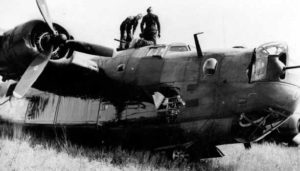 FOOTNOTE Strangely enough we came across another ‘Pregnant Peg’ that operated out of nearby Shipdham and had a very similar story. This was also a B-24H, 42-50328. It returned with one engine out and hydraulic failure after being attacked by fighters on a mission to Politz on May 29th 1944. The pilot, Conrad Menzel, managed to put down on the airfield and the badly damaged aircraft was then repaired using a telegraph pole and flown the short distance to Watton for repair. Menzel went on to complete 30 missions the last on 1st August 1944 and returned home. Re-named “The Flying Log”, although no name was ever painted on her, 328 re-entered service with 406 BS 44BG at Shipdham. On 8th August 1944 during take-off it suffered an engine failure. Aborting the mission the pilot, Lt Myron Jacobs, attempted to get back to the airfield but as a result of turning into the dead engine it spun in and crashed alongside the road at Birds Corner, Yaxham near Dereham at 1155 hours and exploded. All 10 of the crew were killed instantly. It was Myron Jacobs sixth mission. The load comprised 46 x 100lb fragmentation bombs half of which exploded in the crash and others in the ensuing fire.
FOOTNOTE Strangely enough we came across another ‘Pregnant Peg’ that operated out of nearby Shipdham and had a very similar story. This was also a B-24H, 42-50328. It returned with one engine out and hydraulic failure after being attacked by fighters on a mission to Politz on May 29th 1944. The pilot, Conrad Menzel, managed to put down on the airfield and the badly damaged aircraft was then repaired using a telegraph pole and flown the short distance to Watton for repair. Menzel went on to complete 30 missions the last on 1st August 1944 and returned home. Re-named “The Flying Log”, although no name was ever painted on her, 328 re-entered service with 406 BS 44BG at Shipdham. On 8th August 1944 during take-off it suffered an engine failure. Aborting the mission the pilot, Lt Myron Jacobs, attempted to get back to the airfield but as a result of turning into the dead engine it spun in and crashed alongside the road at Birds Corner, Yaxham near Dereham at 1155 hours and exploded. All 10 of the crew were killed instantly. It was Myron Jacobs sixth mission. The load comprised 46 x 100lb fragmentation bombs half of which exploded in the crash and others in the ensuing fire.